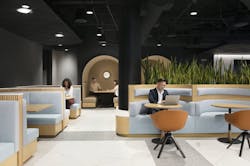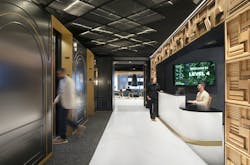1. Know Your Client
Think of your first meeting as you would a blind date. Do your due diligence to gather what information you can beforehand to start to create a picture of who they are and what they value. Get ready to match their energy throughout the project and take the steps necessary to build a lasting relationship. The more you do upfront, the better your results will be.
2. Identify the Decision-Makers
Ask your client to identify who the decision-makers are, what the decision-making process is, and what the decision makers' underlying priorities are. This information will help define the project approach, some of the design solutions, as well as the schedule. We had a project where we presented to the client for each phase. When it came to the final design, we were told we had to present it to the leadership team – surprise! The leadership team had a different perspective on what the design should be. As a result, we had to circle back and redesign some elements and the schedule pushed out four weeks.
3. Illuminate the Vision
It seems obvious, but it’s vital to know why your client, including the decision makers, are doing the project, what their goals are, and what success looks like to them. Are they renewing their lease and want to use their TI dollars to refresh the space? Are they outgrowing their space and need to fit more people in the same amount of space, or are they looking to redefine who they are and to create a space that embodies their goals and vision? Whatever it is, you need to know. It will inform how you approach and design the project.
We had a client that was outgrowing their space, but they did not want to take more space. When we engaged in discussion with them, we learned they had very specific goals in mind: improve transparency; connection and collaboration; create areas for different types of work; remove the hierarchy of different space types; improve the proximity of support spaces to the work areas; embrace their brand. The project was a success. We knew what was needed and approached our design through the lens defined by the client.
4. What’s the Story?
Every design should tell a story. The best designs tell the client’s story. Take what you learned during conversations with the client, craft a story around it, and use that story to help drive decisions.
Gensler created a story for an amenity floor at 200 W. Madison in Chicago that was based on the Louise Nevelson sculpture in the lobby. Nevelson’s art is known for its saturated use of color, shape, texture and materiality. By utilizing a bold and defining element from the building and the artists methods of expression, we were able to capture the spirit of 200 W. Madison and infuse it into the amenity floor. Prospective tenants are told the story when they tour the floor.
The Discover Financial Services Contact Center in the Chatham neighborhood of Chicago includes a 15,000-sq.-ft. Shine Bright Community Center. The project was to take an abandoned big box store and convert it into an office space that would bring jobs to an often-overlooked neighborhood. The story for the project and specifically the community center is so much more. We met with community leaders and asked them a series of questions about their vision. We crafted a story and a design that was about representing, uplifting, and celebrating the people, landmarks and the culture of Chatham. The story also lead to the idea to have a rotating art collection in the community center that featured local artists. Discover is now an integral part of the Chatham community.
5. Clarify the Budget
If a client isn’t direct about the budget, use the resources at your disposal to dial in on what it is. Take them on tours of completed projects to understand what they like and share the costs with them. Are they uncomfortable by the number or does it feel just right to them? Use project photography if you can’t take them on tours. If they have champagne taste on a sparkling cider budget work with them to prioritize the areas that they really want to shine. Typically, it’s the front of house client facing areas and the cafe.
Identify your project partners, GC, furniture vendor, etc., as early as possible. They can provide budget estimates in the design phases to make sure you are staying on track. It’s better to know sooner rather than later if adjustments are required to stay within the budget. This will also avoid a frustrating and time intensive value engineering process.
6. Time is Money
It’s true. Make sure the decision-makers understand the importance of timely feedback and approval. Set a schedule of important milestones and make sure the client knows when you need approval by. Manage their expectations if the feedback or approvals are delayed. You don’t want them to be surprised when they find out you have to push out the issue for permit date because you weren’t given approval to proceed when you needed it. I think we’ve all been in a situation where it took longer than expected to sign the lease, but the client’s move in date has not changed. This compresses the design, documentation and coordination time, and things get missed. Who will they hold responsible? The client won’t remember that they cut a month out of the design and documentation phases.
7. Communicating and More Communicating!
This can’t be stressed enough. Consistent communication with your client, team and consultants will always serve you well. Have regular meetings and keep the lines of communication open. Are you emailing and emailing and not getting the response you need? Pick up the phone. Are you back and forth and back and forth via email with still no understanding of what to do? Pick up the phone. Emails are great for documenting, but you can’t hide behind them. Just last week I had five important questions that I needed the client to weigh in on. It would have taken me at least 15 minutes without interruption to write a coherent email explaining the situation—and who knows how long to get the response. Instead, I picked up the phone. I got all the answers in no more than 10 minutes.
8. Anticipate Changes
Stay agile and know how to pivot when the unexpected happens. Know your market and anticipate where you may encounter issues so you can get ahead of them. Get comfortable with the fact that nothing is linear, and you may have to do things out of sequence.
No one was immune to lead time issues during the pandemic. What did we do? We identified the long lead time items and issued early packages (documents issued before the issue for bid and permit date) for the GC to get a head start on procuring the product. Sometimes we still have to do this, even though the pandemic is behind us. We recently had a project in Nashville where we had to do this because the time frame for a permit was excessive. So, we issued an early package for demo and another early package of lighting, doors, frames and hardware.
9. Build the Best Team
Last but not at all least. A great project manager brings together complementary individuals, including consultants and vendors, to form a dream team. This group has the specific expertise needed to complete the project successfully, they are goal oriented, and share a fluid rapport with each other.
The manager’s job is to provide the framework and support that the team needs to thrive. And when you have the dream team, anything is possible.
About the Author
Kimberly M. Zeiser
Kimberly M. Zeiser is a senior associate and design manager with Gensler Chicago, serving as a liaison between the extended project team and the client on all of her projects that range from media to healthcare to office and beyond. She cultivates lasting relationships that lead to national and global work.



